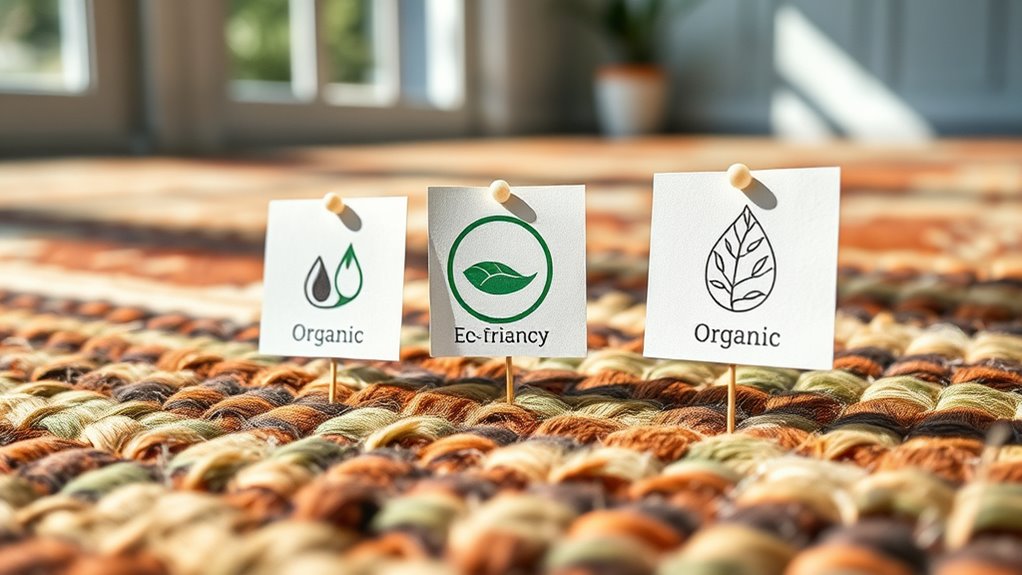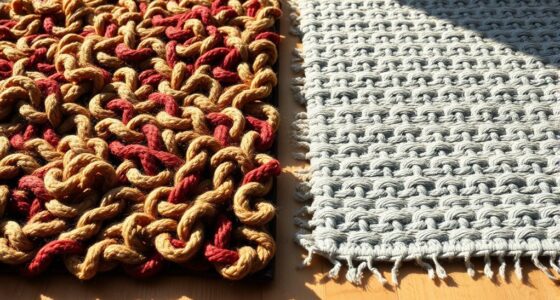Certified organic rug labels show that the materials, dyes, and manufacturing processes meet strict eco-friendly standards. Look for trusted labels like GOTS or USDA Organic, which are verified by recognized certifying bodies. These labels guarantee the fibers are sustainably grown without chemicals, and dyes are natural and non-toxic. To truly understand what a label means, it’s important to authenticate authenticity and what practices are involved—discover more about how to choose genuine certified options.
Key Takeaways
- Certified organic labels like GOTS and USDA Organic verify that fibers and dyes meet strict organic and eco-friendly standards.
- Look for trusted certification logos and documentation to confirm the authenticity of the organic claim.
- Labels indicate the use of natural fibers, non-toxic dyes, and environmentally responsible manufacturing processes.
- Certification ensures transparency, traceability, and compliance with strict environmental and safety regulations.
- Beware of vague claims; verified labels and consistent branding are essential to avoid greenwashing.
Understanding Organic Certification Standards

To guarantee a rug is truly organic, you need to understand the certification standards that verify its authenticity. These standards ensure that the materials and processes used meet strict organic criteria. One key aspect is avoiding synthetic alternatives, which are commonly found in non-organic rugs. Instead, certified organic rugs use natural fibers and dyes, covering a broad dye color spectrum without harmful chemicals. This ensures vibrant, lasting colors while maintaining eco-friendly practices. Certification bodies set these standards to protect consumers and promote sustainable manufacturing. When evaluating a rug, look for verified labels that confirm adherence to these standards. Understanding these details helps you choose a genuinely organic product that aligns with your values and ensures you’re investing in quality, eco-conscious home decor. Additionally, paying attention to dyeing processes can help verify that no toxic chemicals were used during production, reinforcing the importance of organic integrity in your selection.
Common Labels and Their Meanings
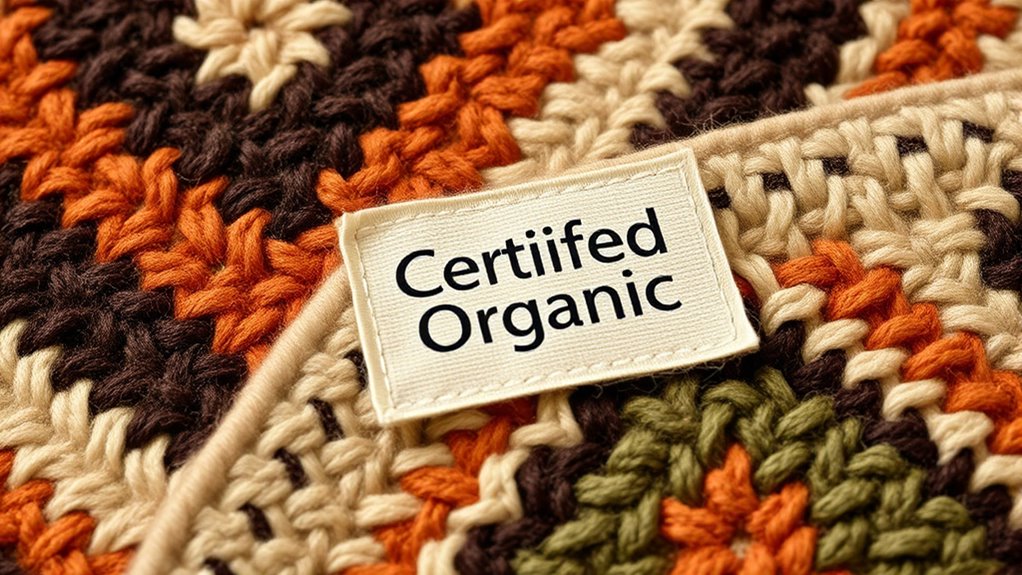
When shopping for organic rugs, recognizing the labels and seals can help you verify their authenticity. Many labels indicate organic or eco-friendly materials, but beware of synthetic alternatives that mimic natural fibers. Common eco labels, like GOTS or OEKO-TEX, clarify a rug’s organic credentials, but eco label confusion can make it tricky to distinguish genuine certification from misleading claims. Some rugs may carry seals suggesting organic quality, yet still contain synthetic fillers or dyes. Always check for specific certification logos and understand what they represent. Labels like “Made with Organic Materials” might sound trustworthy but don’t guarantee full organic integrity. Educating yourself on these common labels helps you avoid deception and ensures your rug truly aligns with your eco-conscious values. Additionally, understanding the power consumption of heated mattress pads can help you make energy-efficient choices for your home. Being aware of different fiber types used in rug manufacturing can also assist in selecting environmentally friendly options that meet your standards. Knowing how to interpret industry-standard eco labels can further protect you from unverified claims and ensure your purchase supports sustainable practices.
Recognized Certifying Bodies for Organic Rugs
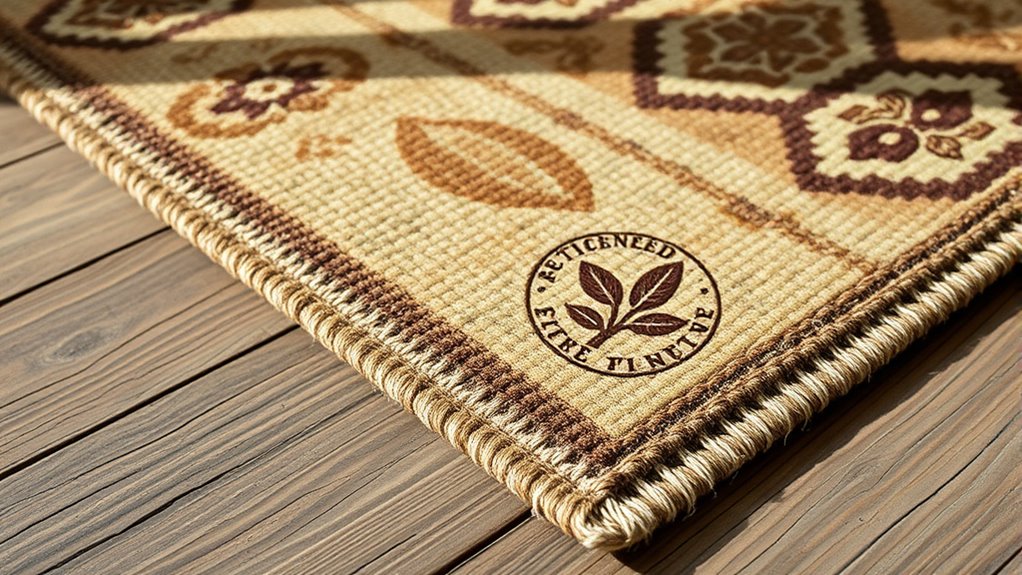
Recognized certifying bodies play a crucial role in verifying the organic claims of rugs, giving consumers confidence in their purchase. These organic certification agencies set strict standards that manufacturers must meet to earn certification. When you see rug certification logos on a product, it indicates that an independent organization has reviewed the rug’s materials and production processes, ensuring they meet organic criteria. Popular certifying bodies include the USDA Organic, GOTS (Global Organic Textile Standard), and OEKO-TEX. Each uses distinct logos that help you identify certified organic rugs easily. Knowing which certifying agencies are recognized helps you make informed choices and avoid misleading claims. Always look for these trusted logos to confirm that the rug genuinely meets organic standards. Additionally, understanding certification standards can help you better evaluate the authenticity of organic claims in the marketplace. Recognizing certification labels can also assist in distinguishing genuine organic products from those with false or misleading labels. Being familiar with certification processes further ensures that you select products that truly adhere to organic principles.
Materials and Processes Certified as Organic
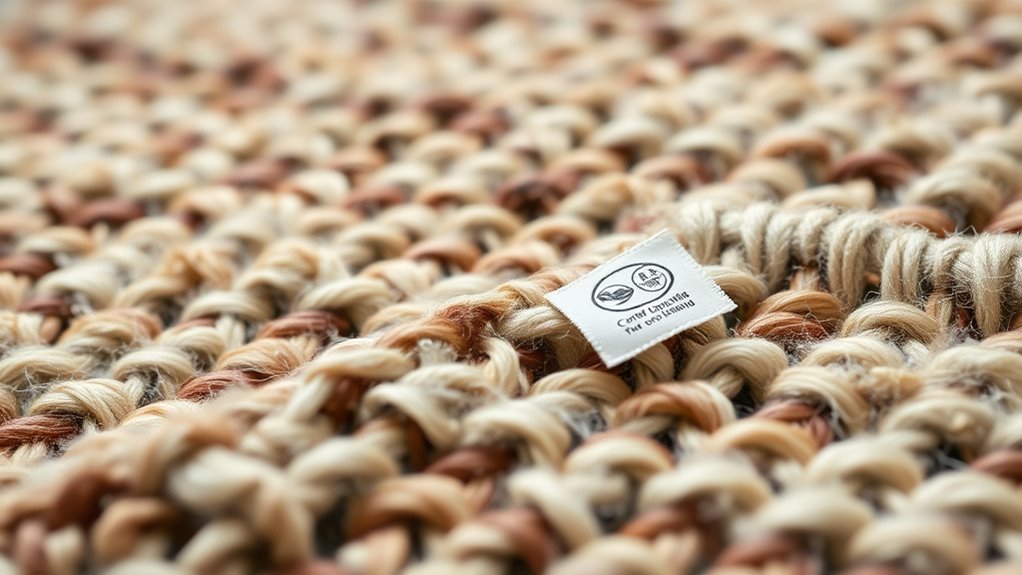
When choosing an organic rug, you should look for certified organic fiber sources like wool or cotton that meet strict standards. Eco-friendly manufacturing methods guarantee the process minimizes environmental impact, while non-toxic dyes assure safety for your home. Self Watering Plant Pots help reduce waste and promote sustainability throughout their lifecycle. Using certified manufacturing processes ensures the entire production follows environmentally responsible practices, giving you added confidence in your purchase. Additionally, verifying vetted products ensures the rug has undergone rigorous safety and efficacy assessments. Incorporating skin-safe dyes in the manufacturing process further enhances the safety and quality of your organic rug.
Organic Fiber Sources
Organic fiber sources for rugs are carefully cultivated and processed to meet strict certification standards, ensuring that the materials are truly organic from start to finish. You’ll find natural fiber varieties such as wool, cotton, jute, and sisal, all derived from plant-based materials that are grown without synthetic chemicals or pesticides. These fibers are harvested, cleaned, and prepared using certified organic methods, preserving their natural qualities. Incorporating sound healing science into sustainable practices can enhance the health benefits of organic rugs, promoting a healthier indoor environment. Choosing rugs made from organic fiber sources means you’re supporting sustainable farming practices and reducing exposure to harmful toxins. Because the certification verifies the organic origin of these fibers, you can trust that your rug’s materials are environmentally friendly and free from synthetic additives. This commitment to organic fiber sourcing helps promote healthier homes and a more sustainable planet. For example, fibers like jute are cultivated in eco-friendly ways that minimize environmental impact.
Eco-Friendly Manufacturing Methods
Eco-friendly manufacturing methods for organic rugs prioritize sustainable practices at every stage, ensuring that both materials and processes meet strict organic standards. You’ll find that manufacturers use sustainable supply chains, sourcing raw materials responsibly to minimize environmental impact. These companies often implement energy-efficient processes and reduce waste during production, supporting eco-conscious practices. Additionally, they opt for eco conscious packaging, using biodegradable or recyclable materials to further lessen environmental footprints. Such methods guarantee that the entire manufacturing cycle aligns with organic principles, from raw material extraction to finished product. Incorporating sustainable supply chains ensures that every step of production adheres to eco-friendly standards, reinforcing the commitment to environmental responsibility. Moreover, many eco-friendly manufacturing methods involve reducing chemical use, which is crucial for maintaining the integrity of organic products. Choosing methods that utilize clean energy sources can further decrease the carbon footprint of production. Implementing energy-efficient processes not only conserves resources but also reduces overall emissions during manufacturing. By choosing rugs made through eco-friendly manufacturing, you support sustainable development and help protect the planet, all while enjoying high-quality, certified organic rugs that meet rigorous standards.
Non-Toxic Dyes Used
Have you ever wondered how organic rugs stay true to their eco-friendly claims? The secret lies in the non-toxic dyes used during production. Certified organic rugs often feature natural pigments derived from plant based dyes, ensuring no harmful chemicals are involved. These dyes are gentle on the environment and safe for your home, reducing toxic exposure. By using plant based dyes, manufacturers avoid synthetic colorants that can release volatile organic compounds (VOCs). The vibrant, lasting colors come from carefully sourced botanical extracts, which are processed without toxic chemicals. This commitment to natural pigments not only preserves the integrity of the organic label but also promotes sustainable practices. Additionally, compliance with safety standards can help ensure the dyes used meet strict environmental standards, further guaranteeing the product’s authenticity. When you see a rug labeled as organic, you can trust it’s been dyed with eco-friendly, non-toxic methods that prioritize health and the planet.
Verifying Authenticity and Avoiding Greenwashing

You need to recognize genuine certification indicators to guarantee a rug is truly organic. Be cautious of greenwashing tactics that companies use to appear eco-friendly without real credentials. Knowing what to look for helps you make informed choices and avoid being misled.
Authentic Certification Indicators
To guarantee you’re truly choosing organic rugs, it’s essential to recognize genuine certification indicators that verify authenticity. Look for clear organic labeling and trusted certification logos on the product. Here are four key indicators:
- Official Certification Logos – Verify they match recognized standards like GOTS or USDA Organic.
- Consistent Organic Labeling – Check for uniformity in labels across the product and packaging.
- Certifying Agency Details – Reliable labels include the certifier’s name and contact information.
- Traceability and Documentation – Authentic rugs often come with certificates or receipts confirming their organic origin.
Spotting Greenwashing Tactics
While many brands promote their rugs as eco-friendly, some may engage in greenwashing to appear more sustainable than they truly are. To spot tactics like this, look beyond labels. Check if the brand highlights sustainable packaging and fair labor practices—these are key indicators of genuine sustainability. Be cautious of vague claims like “eco-friendly” without specifics. Verify certifications and ask for transparency about sourcing and manufacturing. Some companies may use misleading language or omit details to mask unsustainable practices. Use this table to identify red flags:
| Greenwashing Tactics | What to Look For |
|---|---|
| Vague eco claims | Specific certifications and transparent sourcing |
| Hidden labor issues | Clear info on fair labor practices and sustainable packaging |
| Excessive packaging claims | Evidence of eco-conscious packaging choices |
| Lack of third-party verification | Authentic certifications from reputable organizations |
The Importance of Transparency in Certification

Transparency in certification is essential because it builds trust between consumers and brands, ensuring that claims about organic rugs are genuine. When you see clear transparency importance, you can confidently verify that the rug’s certification trust is legitimate. Without transparency, false claims can easily slip through, undermining your confidence. To understand the value, consider these points:
Transparency in certification builds trust and guarantees genuine organic rugs.
- Clarity on sourcing and materials used
- Clear documentation of certification processes
- Visible proof of compliance with standards
- Open communication about testing and inspections
These details help you assess whether a rug truly meets organic standards. Transparency isn’t just about honesty; it’s about empowering you to make informed choices. When brands prioritize transparency importance, they demonstrate their commitment to authenticity and your trust.
Caring for Your Organic Rug to Maintain Certification
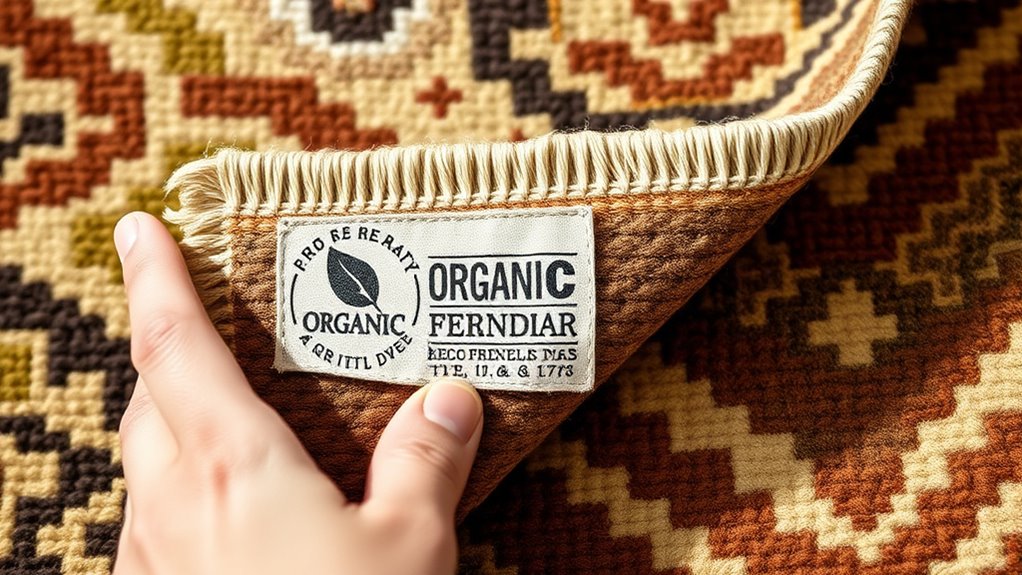
Proper care is essential to safeguard your organic rug’s certification and ensure it continues meeting strict standards. To do this, avoid harsh chemicals and opt for gentle cleaning methods that preserve organic dyeing. Regular vacuuming helps prevent dirt buildup, which can degrade natural fibers over time. When cleaning, use eco-friendly, certified non-toxic solutions to maintain the integrity of the dyes and fibers. Additionally, supporting fair trade sourcing ensures your rug’s materials were ethically produced, promoting sustainable practices. Keep your rug out of direct sunlight to prevent fading of organic dyes. Rotate it periodically to distribute wear evenly. By following these steps, you uphold the standards of organic certification, ensuring your rug remains a genuine and environmentally responsible piece for years to come.
Tips for Choosing Genuine Certified Organic Rugs

When shopping for organic rugs, it’s essential to verify their certification to guarantee you’re getting a genuine product. To assure authenticity, consider these tips:
- Look for reputable certification labels linked to organic farming standards.
- Ask about the rug’s sourcing to confirm sustainable sourcing practices.
- Research the manufacturer’s commitment to organic and eco-friendly materials.
- Trust brands that prioritize transparency in their supply chain.
Frequently Asked Questions
How Long Does Organic Certification Typically Last Before Renewal?
You wonder how long organic certification lasts before renewal. Typically, the certification validity is about one year, and you need to go through the renewal process annually. This renewal process guarantees your rugs continue meeting organic standards. Staying on top of renewal deadlines is essential, as missing them could mean losing certification. Regular renewals help verify that your products consistently adhere to organic guidelines, maintaining trust and quality in your certified rugs.
Are There Regional Differences in Organic Rug Certifications?
You might notice regional standards vary when it comes to organic rug certifications, as different certification agencies set specific rules. These agencies often tailor their standards to local environmental and industry needs, meaning that a rug certified organic in one region might not meet the requirements elsewhere. Always check the certification label to see which agency issued it, ensuring you’re getting a truly organic product based on the regional standards.
Can Non-Certified Rugs Be Eco-Friendly or Sustainable?
You can find eco-friendly or sustainable rugs even if they aren’t certified, but you need to look closely. Non-certified rugs might use natural fibers and avoid harmful chemical treatments, making them better for the environment. However, beware of synthetic fibers and chemical treatments that can compromise sustainability. Always ask about the materials and manufacturing processes to guarantee you’re choosing a genuinely eco-conscious rug.
What Are Common Signs of Counterfeit Organic Labels?
When checking for counterfeit labels, you should look for authenticity indicators like clear, detailed certifications and consistent branding. Be cautious if labels seem blurry, lack specific certifying organization details, or have misspellings. Counterfeit labels often imitate genuine ones but lack official seals or proper accreditation. You actively verify these signs to guarantee the rug’s organic claim is legitimate, helping you avoid fakes and support authentic, eco-friendly products.
How Do Certification Standards Evolve Over Time?
You wonder how certification standards evolve over time, shaping the labels you trust. Certification standards adapt through ongoing research, technological advances, and market demands, ensuring products meet higher safety and sustainability benchmarks. Label evolution reflects these changes, becoming more detailed and transparent. As standards tighten, you benefit from more reliable information, knowing that the labels on organic rugs are continually improving to meet new environmental and health expectations.
Conclusion
By understanding labels, verifying certifying bodies, and caring for your rug, you protect your investment, support sustainable practices, and guarantee authenticity. Recognize the significance of transparency, stay informed about materials and processes, and choose genuine certification. Make conscious decisions, demand honesty, and prioritize quality. Because when you know what to look for, you ensure your organic rug remains authentic, eco-friendly, and beautiful — now, tomorrow, and for years to come.
